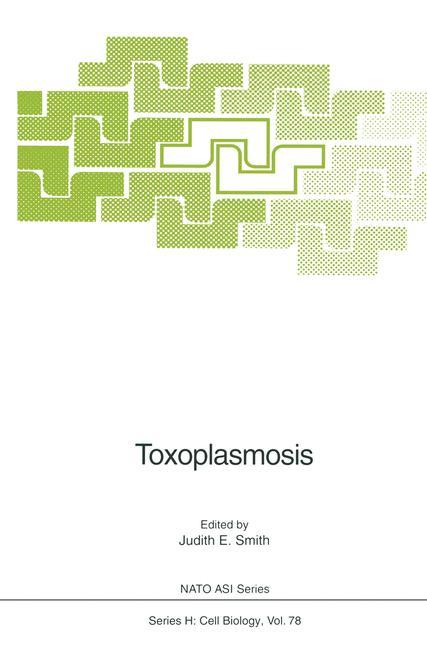
Zustellung: Do, 28.11. - Sa, 30.11.
Versand in 2 Tagen
VersandkostenfreiBestellen & in Filiale abholen:
Although long known as a parasite of medical and veterinary importance, interest in Toxoplasma gondii has increased with its emergence as a major cause of death in immunosuppressed individuals, and with recognition of its suitability as a model system for molecular and cellular investigations of apicomplexan parasites. The NATO workshop brought together 32 scientists working in different areas of toxoplasmosis research to gain an overview of progress in the field. Molecular studies have been carried out on genomic and extrachromosomal DNA. They reveal that Toxoplasma is very highly conserved, genetic mapping is underway and preliminary linkage analysis suggests recombination is rare; moreover all virulent strains share the same isoenzyme markers and are seen to be essentially clonal by RFLP analysis [Boothroyd, Darde, Wilson]. Despite considerable structural homology between Toxoplasma and related apicomplexan parasites there is little direct overlap in gene sequence data. Good progress has been made in cloning functional genes and in elucidation of PI anchors [Cesbron-Delauw, Johnson, Mercereau-Puijalon, Striepen]. The structure of molecules on the surface and within dense granules, rhoptries and micronemes has in some cases been determined and provides clues as to the targetting and function of these proteins.
Inhaltsverzeichnis
Molecular Biology. - Allelic polymorphyism in Toxoplasma gondii: implications for interstrain mating. - Study of genetic polymorphism of Toxoplasma gondii through isoenzyme analysis. - Expression of apical organelle antigens by a Toxoplasma gondii genomic library. - Dense granule antigens of Toxoplasma gondii. - A strategy for cloning a DNA polymerase gene of Toxoplasma gondii. - Extrachromosomal DNA in the Apicomplexa. - Cell Biology. - Formation and modification of the parasitophorous vacuole occupied by Toxoplasma gondii. - The parasitophorous vacuole membrane surrounding T. gondii: a specialized interface between parasite and cell. - Toxoplasma gondii: Motility and Invasion. - Toxoplasma gondii: Patterns of bradyzoite-tachyzoite interconversion in vitro. - The growth and development of Toxoplasma gondii tissue cysts in vitro. - Recent advances in the glycobiology of Toxoplasma gondii. - Immunology. - Role of P30 in attachment and immunity to T gondii. - Secretory IgA, antibody to SAG1, H-2 class I-restricted CD8+ T-lymphocytes and the INT1 locus in protection against Toxoplasma gondii. - Factors responsible for development of toxoplasmic enchephalitis in immunocompromised hosts. - Synergistic and compensatory roles of CD4+, CD8 + T-lymphocytes and natural killer cells in resistance to Toxoplasma gondii. - Human T-cell clones as tools to identify protective antigens of Toxoplasma gondii. - Protection of mice and nude rats against Toxoplasmosis by an octomaeric construct of the P30 48 67 peptide. - Toxoplasmosis Vaccines Diagnosis & Chemotherapy. - Synergistic drug combinations in the treatment of toxoplasmosis. - Toxoplasma gondii: Chemotherapy. - Diagnosis of Toxoplasma gondii infections by molecular detection. - Use of Toxoplasma gondii recombinant antigens for diagnosis andseroepidemiology. - Progress towards the development of a vaccine against congenital toxoplasmosis: Identification of protective antigens and the selection of appropriate adjuvants. - Development of a live vaccine against ovine toxoplasmosis. - Abstracts. - Genetic regulation of Toxoplasma gondii infection: influence of LSH/ITY/BCG gene. - Establishing a laboratory for parasitic genome analysis: focus on the parasitic protozoa Toxoplasma, Trypanosoma and Leishmania. - Mucosal immune response in Tpxoplasmosis. - Antenatal screening for Toxoplasmosis in Turkiye. - Toxoplasmosis in Greece: Serological studies. - Critical evaluation of IgA antibodies as an indication of early Toxoplasma-infection. - Expression of Toxoplasma gondii genes in rBCG.
Produktdetails
Erscheinungsdatum
22. November 2011
Sprache
englisch
Auflage
Softcover reprint of the original 1st ed. 1993
Seitenanzahl
284
Reihe
Nato ASI Subseries H:
Herausgegeben von
Judith E. Smith
Verlag/Hersteller
Produktart
kartoniert
Gewicht
435 g
Größe (L/B/H)
235/155/16 mm
Sonstiges
Paperback
ISBN
9783642785610
Entdecken Sie mehr
Bewertungen
0 Bewertungen
Es wurden noch keine Bewertungen abgegeben. Schreiben Sie die erste Bewertung zu "Toxoplasmosis" und helfen Sie damit anderen bei der Kaufentscheidung.









